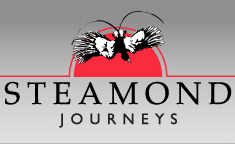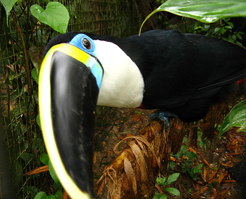
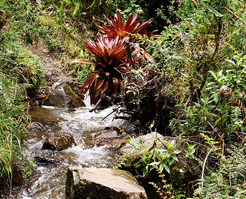
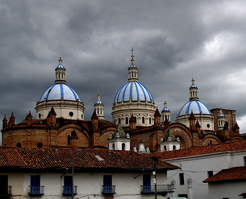
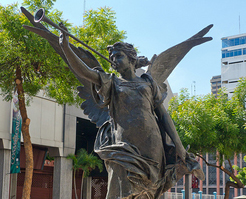
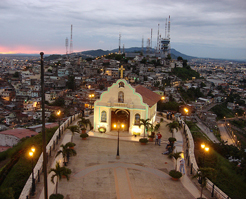
Telephone:
E:
Area
Although covering just 256,370 sq. km. (99,130 sq. miles) Ecuador contains one of the most varied geographies in South America. There are four distinct regions: the Andean highlands, the coastal tropical plains, the Amazon Basin and the Galapagos Islands, located 1,000 km. (600 miles) off the coast in the Pacific Ocean. Quito, on the highlands, is the capital city; Guayaquil, on the coast, is the main port and the largest city in the country.
Buses
Public buses running in main cities such as Quito and Guayaquil from 6 till 10 pm, ride cost average 0.25cts in any direction.
Car Rental
Available at main airports Quito, Guayaquil, Manta, Cuenca and Loja.
Opening in business hours and weekends.
Climate
Ecuador has a land area similar in size to England or the State of Colorado (USA) and is divided into four different geographic zones: the Amazon, the highlands, the Pacific lowlands and the Galapagos Islands. Since Ecuador is located right on the equator, the country as a whole experiences no extreme weather changes. Rainy seasons vary in each zone. See our specific brochures for information on each area. In the tropical rainforest it is best to be prepared for all kinds of weather. A common question we receive is about the “dry and rainy seasons” of the Amazon, but it is best not to trust such generalizations to plan a trip. At times it can be hot and sunny, but a cool rainstorm may appear at a moment's notice during any time of the year.
Customs & Immigration
Each passenger is allowed two bags of up to 70 pounds (31.8 kilos) each, plus carry-on luggage, photo or video camera, and binoculars. Professional filming equipment, diving and climbing gear require special permits.
Diving
Available in the GPS islands as the most important diving spot you would find here good diving operators that will help you at any time.
Dress
Lightweight woolens are ideal for the highlands; and warm jackets are essential after dusk at high altitudes. Cottons Pacific lowlands and Galapagos. Dress is informal. Dressing in layers is ideal. Do not forget swimming wear and comfortable walking shoes.
*Please remember to dress respectfully, covering shoulders and knees if visiting any Catholic churches or monuments.
Drink
Bottled mineral water, with or without carbonation, is available at all hotels, ships and lodges. Ecuadorian beer is excellent, and bottled soft drinks are available everywhere. Coffee and tea are usually served at the end of meals.
Eating Out
International cuisine is available throughout the country, but try some of the Ecuadorian specialties: humitas and tamales (made of corn and wrapped in leaves), llapingachos (fried mashed potato patties with cheese), ceviche (a saucy shrimp cocktail), and locro (a soup of stewed potatoes and cheese topped with an avocado). There are many excellent restaurants in the main cities and a restaurant guide is distributed free to all visitors upon arrival in Ecuador.
Electrical Current
110 volts, 60 cycles AC is used. Most outlets are for two flat prongs. It is useful to carry a small flashlight. For TV and video equipment, Ecuador uses the NTSC system.
Language
Ecuador's official language is Spanish, but Kichwa, the lingua franca of the Inca Empire, is the tongue of the majority of the Indian population. English is spoken in major visitor centers.
Media
All media available in Ecuador such as internet (available in most hotels country wide), telecommunications (phone connections country wide) , networks, cable networks, newspapers and multimedia.
Money, Banks & Credit Cards
Ecuador's currency is the Dollar of the United States of Americas. U.S. dollars are used for all transactions. There is no restriction on the amount of foreign currency or travelers checks brought into Ecuador. Most city offices and shops open from 9:00 to 18:00 Monday through Friday. Currency exchange facilities are open week days and Saturday morning in major hotels. Banking facilities are not available in remote areas. U.S. dollars are accepted throughout the country. ATM's are easily found throughout the main cities. Cash advances can be made at most banks or ATM's.
Population
Of Ecuador's more than 13.2 million inhabitants, those in the highlands are mainly mestizo, a mixture of European and Native South American extractions. Indigenous peoples live mainly in the Andean highlands and in the Amazon regions. Coastal dwellers are descendants of Native South Americans, Europeans and Africans
Public Holidays
Ecuador's public holidays mostly celebrate historic events and religious festivals. Some public holidays are national and apply to the whole of Ecuador, some are local to a particular city. A public or bank holiday may be applied on a Friday if the actual date falls at the weekend or midweek. In this case it is common for festivities to happen on the actual date and then people have the day off on the official date anyway, thus getting two holidays for the price of one. Some celebrations are not actually public holidays, but the public stop working and celebrate anyway and there is very little that the government can do about it. In general, if there is an excuse for a party, people in Ecuador will celebrate it.
• January 1: New Year's Day*
• January 6: Three Kings Day (a.k.a. Epiphany)*
• February 12: Anniversary of the Discovery of the Amazon River. Province Day (Galápagos)
• February 27: National Community Spirit Day
• March and/or April: Carnival* – Celebrated just before Lent, Carnival is the ultimate party in the Catholic nations of Latin American. While not as extravagant in Ecuador as in other Latin American countries, celebrations here include waterfights and lavish parades. Ambato is a good destination with its famous fruit and flower parade takes place. Although the dates change annually according to the religious calendar, Carnival is always celebrated as an extended weekend prior to Ash Wednesday.
• Easter and Holy Week*: Religious processions and an endless supply of fanesca (a delicious, typical stew eaten throughout the week) mark Palm Sunday, Holy Thursday, Good Friday, Holy Saturday, and Easter Sunday. Holy Saturday is the only official holiday on which stores must be closed, and merchants decide to open or close on the other days. Beaches can get packed during Holy Week.
• May 1: Labor Day* – Typical parades and processions fill the streets of Ecuador, honoring workers worldwide..
• May 24: Battle of Pichincha* – Military and civilian parades mark the day in 1822 when the country's most important battle in the war for independence from Spain was fought.
• June: Corpus Cristi – Usually celebrated on the 9th Thursday after Easter, this religious holiday/traditional highlands harvest celebration includes ceremonies and dancing.
• June 24: Saint John the Baptist – Celebrations in Otavalo and the surrounding highland communities.
• June 29: Saints Peter and Paul – Celebrations in Otavalo and the surrounding highland communities.
• July 24: Simón Bolívar's Birthday*– A nationwide celebration of the birthday of the famous South American liberator.
• July 25: Founder's Day, Guayaquil – For two days, Guayaquil enjoys its biggest celebration of the year. The ciity shuts down for two days to celebrate Simón Bolívar's birthday and the foundation of Ecuador's most populous city.
• August 10: Quito Independence Day*
• September: Various harvest festivals throughout the country.
• September 1-15: Fiesta del Yamor – An annual festival in the highland town of Otavalo.
• September 23-24: Our Lady of Mercy Festival (Latacunga) – Parades and parties follow religious processions.
• October 9: Guayaquil Independence Day* – Once again, Guayaquil combines holidays (Independence Day and Columbus Day) enjoying a multi-day festival.
• October 12: Columbus Day* – Also known as "Día de la Raza" (Day of the Race), Columbus Day celebrates the day in 1492 on which Christopher Columbus (Cristobal Colón) first set foot on American soil in what is now known as the Dominican Republic.
• November 1: All Saints' Day*
• November 2: All Soul's Day (a.k.a. "Day of the Dead")* – On All Soul's Day, families visit cemeteries to dance, drink, eat, and leave flowers and other offerings for deceased friends and relatives in a convivial ceremony designed to celebrate the lives of those who have passed on.
• November 3: Cuenca Independence Day* – The culmination of three days of festivities, this is the final day of Cuenca's biggest annual celebration.
• November 11: Latacunga Independence Day.
• December 6: Founder's Day, Quito - Fiestas de Quito – The air in Quito takes on a more festive spirit throughout the first week of December as Quiteños take in bullfights, parades, and street dances, and ride around Quito atop Chivas (open-air party buses complete with live music and drinks). Also known as "Fiestas de Quito", this week is the opening act to a month-long gala for many.
• December 24: Christmas Eve*
• December 25: Christmas Day*
• December 28-31: Year's End Celebrations – Staring with the Day of the Innocents, the entire nation symbolically prepares to enter a new year by burning human figurines in the streets as Quiteños end a nearly month-long party.
Public holidays in Ecuador are often celebrated with family, which for many people means travelling back to their home town or village. Consequently buses are often packed around these dates, so either try to avoid travelling around public holiday dates, if possible, or else reserve a ticket ahead of time
Railways
Available only for tourist purposes in the segments from Quito to Cotopaxi form Riobamba to Alausi.
Taxis
Available 24/7 yellow cabs; average rate ride in main cities such as Quito and Guayaquil $5.00 in any directions within the urban boundaries.
Telephone Services
Telecommunications (phone connections country wide, with access to international phone calls, mobile networks available also.)
Time
Local time on the mainland is Greenwich Meridian Time minus 5 hours (Eastern Standard Time in the United States). Galapagos time is GMT minus 6 hours.
Vaccinations
No inoculations are required for entry Ecuador. Travelers with heart conditions or high blood pressure should check with their physicians about high-altitude travel, as well as preventive measures for visiting tropical areas. Bottled water is advised and available everywhere.
Please take any medication you may need with you..
Visas
Valid passports are required for entry into Ecuador. No visas are needed for stays of up to 90 days. Before landing, your airline will give you an embarkation/disembarkation card to be filled out and presented to the Immigration officer.
Taxes
There is a sales tax added to purchases; hotels and restaurants charge sales tax and service. There is also an international departure tax is to be paid in U.S. Dollars at the airport.
Park Fees
Visitors to the Galapagos Islands must pay entrance fees. Such prices vary and are not included in tour rates.
Tipping
As in many places, gratuities are customary, but entirely at guest's discretion. Guidelines for tipping will be found in the "Welcome Kit" you receive upon arrival. Examples include:
• Guide: US$ 6
• Driver: US$ 3
• Restaurant: A 10% tip of your bill is expected
Luggage
Because of the size of the aircraft it is imperative to limit your luggage to a basic minimum weight; the maximum allowed is 20 pounds (11 kilograms) per passenger including hand luggage, in case of excess baggage the airline will charge you 1.40 usd per each extra pound. We strongly suggest traveling with backpacks instead of suitcases.
One large backpack or one duffel bag. One small daypack. Storage for excess luggage which is not needed for this trips can be stored at the hotel designated in this program and sent along with our local guides to take it to await for passengers to arrive after their trip, please make sure all luggage is properly labeled if extra luggage will be storage.
Please be aware that there may be a significant difference on the luggage allowance between your international flights and your internal flights. Typically international flights allow 20 kilograms of baggage in economy and 30 kilograms in business class or first class. Flights that operate via the United Status for example use the piece system and offer an allowance of two pieces of luggage with a weight restriction per bag of 20 kilograms in economy and 30 kilograms in business or first class.
No more than 20 Kilos (44 pounds) of luggage (one suitcase) may be checked on flights to or from Guayaquil to Quito Additional luggage can be sent to the hotel in Quito and stored at your hotel. These restrictions do not include small carry-on flight bags or camera cases.
